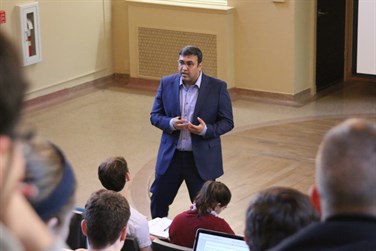 The Department of Mechanical Engineering at Texas A&M University currently has 13 full-time professors at the Texas A&M University at Qatar campus. Each year Dr. Andreas Polycarpou, head of Texas A&M’s Department of Mechanical Engineering, works with the program chair for the Qatar program to select one faculty member to travel to the College Station, Texas, campus to conduct research and teach current mechanical engineering students.
The Department of Mechanical Engineering at Texas A&M University currently has 13 full-time professors at the Texas A&M University at Qatar campus. Each year Dr. Andreas Polycarpou, head of Texas A&M’s Department of Mechanical Engineering, works with the program chair for the Qatar program to select one faculty member to travel to the College Station, Texas, campus to conduct research and teach current mechanical engineering students.
Through this exchange professors from both campuses have the opportunity to work in world class facilities, work with students from around the world and continue to add to the engineering knowledge base.
For the 2015 academic year Dr. Bilal Mansoor, an assistant professor in mechanical engineering at Qatar, was selected to come to College Station and conduct his research on multifunctional materials.
There is great interest in designing new light-weight structural materials that not only have high strength and stiffness attributes, but also possess other unique properties that can be tailored precisely to their intended use. Nature offers many examples of structural materials that adequately perform multiple important functions.
An example of this is the human bone. With a complex mix of compact and porous internal architecture, not only does it provide the structural stability necessary to keep humans standing upright, it also helps in blood cell production, mineral storage and more essential life functions.
Mansoor is the director of the Multifunctional Materials and Manufacturing Laboratory (M3L). The laboratory’s research is seeking to understand the interplay between structural characteristics and behavior of novel, multifunctional materials under different loads and extreme environments. The M3L team is currently utilizing funds from multiple Qatar National Research Fund grants to develop new multifunctional materials and related manufacturing technologies, which seek to emulate the intricate designs found in nature.
The research team is currently working on hybrid metallic foams with potential applications in transportation, medicine and energy storage and conversion industries. Metallic foams are extremely expensive and are only used in some niche commercial applications. The research on metallic foams is heavily focused on the foaming process to create metallic foams with nature inspired controlled porous architectures.
In addition, the M3L researchers are working to develop a novel manufacturing process to create intricate geometry metallic foam parts at high volumes and low cost for practical applications. Once established, this novel manufacturing method will promote the use of metallic foams in a range of important applications such as energy absorbing crash structures, heat exchangers, vibration dampers, filters, catalysts, thermal insulation and biomedical implants for bone and tissue ingrowth.
Mansoor believes materials with multi-functional properties are the building blocks of the future and will have significant future economic and societal relevance. Use of these materials will allow engineers to develop cheaper, more efficient designs that will significantly reduce our carbon footprint.